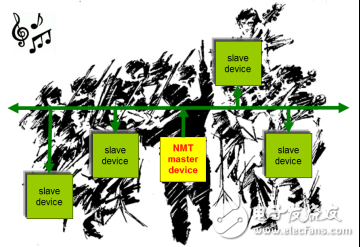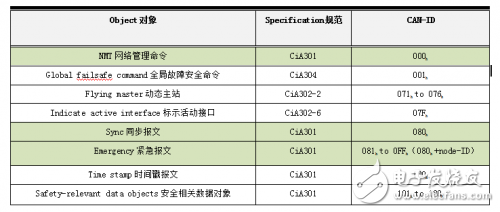People often choose CAN over RS485 because of its real-time burst transmission capability. However, in multi-node and long-distance applications, without proper optimization, both CAN and RS485 may not show significant advantages. So, how can CAN communication outperform traditional methods? The answer lies in CANopen.
At the beginning of CANopen, even in the automotive industry—which is one of the most widespread applications of CAN—there were relatively few nodes and limited communication needs. This made CAN a suitable choice for real-time communication. But when it comes to more complex environments with many nodes or long distances, CAN's performance may fall behind RS485. For example, at the same baud rate, CAN's maximum distance is only about 60-80% of what RS485 can achieve. Additionally, in multi-node systems, CAN cannot support arbitrary burst transmissions like RS485. It must follow a polling mechanism, which can lead to congestion if not properly managed, as shown in Figure 1.

Figure 1: CAN’s burst advantage and multi-node congestion
The designers of CANopen were well aware of the limitations of the CAN bus. Therefore, they developed CANopen as a real-time communication protocol for small networks and control signals. To achieve this, several key design principles were followed:
- Message transmission uses the standard CAN frame format, with an 11-bit ID field to minimize transmission time.
- Network control messages use the minimum number of data bytes. For instance, a heartbeat message contains just 1 byte of data.
- Real-time process data does not require a response from the receiving node, using a producer-consumer model to reduce bus load.
- Configuration parameters that require acknowledgment are typically transmitted in fast words, allowing up to 32 bytes per message, avoiding real-time degradation due to framing.
These features are all aimed at maximizing real-time performance while keeping the system efficient. To simplify network setup, CANopen also defines a mandatory default identifier (CAN frame ID) allocation table, reducing the learning curve for users and enabling quick deployment.
Network Management (NMT) and Special Protocols
Although CANopen operates on the CAN bus where all nodes have equal communication rights, stability and reliability require a Network Management Master (NMT-Master). Like a conductor in an orchestra, the NMT-Master controls the start and stop of all nodes, as shown in Figure 2.

Figure 2: NMT-Master as a symphony conductor
The NMT-Master is usually a PLC or PC with monitoring capabilities in the CANopen network, making it a master station. Other nodes are referred to as NMT-slaves.
Messages exchanged between the NMT-Master and NMT-slaves are called NMT network management messages. These messages handle layer management, network configuration, and ID distribution. They include tasks such as initialization, configuration, and network protection. In a typical CANopen network, there is only one NMT-Master and one or more NMT-slaves operating in a master-slave mode.
To coordinate synchronization, heartbeat, time, and error reporting among nodes, CANopen also defines a set of special protocols. As shown in Table 1, these messages are pre-defined with specific CAN-IDs for NMT and special protocol communications.
Table 1: CAN-ID definitions for NMT and special protocols

The CAN-ID used for these messages is known as the COB-ID. Readers should remember the meanings of these commonly used green-shaded CAN-IDs. In practice, these three types of messages are the most frequently used in CANopen networks.
The USBCAN-EP and PCI-5010-P master cards allow PCs to expand into CANopen communication interfaces, supporting data exchange via the CANopen protocol. As the network administrator, these cards implement all NMT functions required for CANopen networks.
19mm key switches
19mm key switches, ie, Key Switch lock, is gradually increase market share with its Diverse functions, accurate operation and Wide range of applications
This 19mm key switches could have 3 position key switch, 4 Position key Switch, which means it could have stronger power to support industrial and other bigger equipment. The exclusive technology of reset functions, multi-position rotation angles are not available in all walks of life,only we can have the technique to realize these.

As for the quality, this 19mm key switches have via UL authentication. In terms of green environmental protection, we adhere to the concept of sustainable development from the procurement of raw materials to the shipment of finished products. Meanwhile, we have professional environmentalist in charging of the whole production system, ROHS environmental protection providing PPAP report for our customers.
At present, our company's power key switches matching detection equipment is roughly as follows:ROHS testing machine, projector, life testing machine, push-pull testing machine, secondary element microscope, power testing machine, salt spray testing machine, etc.
With a sound quality control system and reliable detection equipment, we has created a globally reliable power key switch and has become a trusted producer of electrical key switches.
Key Switches,Key Switch Lock,Lock Switch,Power Lock Key Switch,Power Switch Lock,Power Lock Switch,Power Key Lock,19Mm Key Switches,4 Position Slide Switch,19Mm Push Button Key Switch,19Mm 3 Position Key Switch
YESWITCH ELECTRONICS CO., LTD. , https://www.yeswitches.com